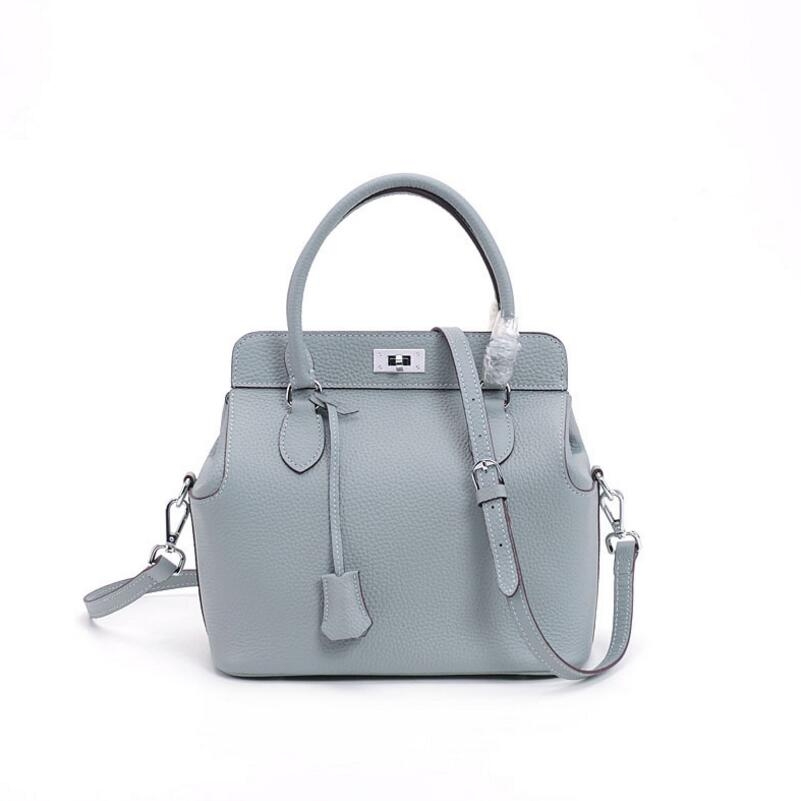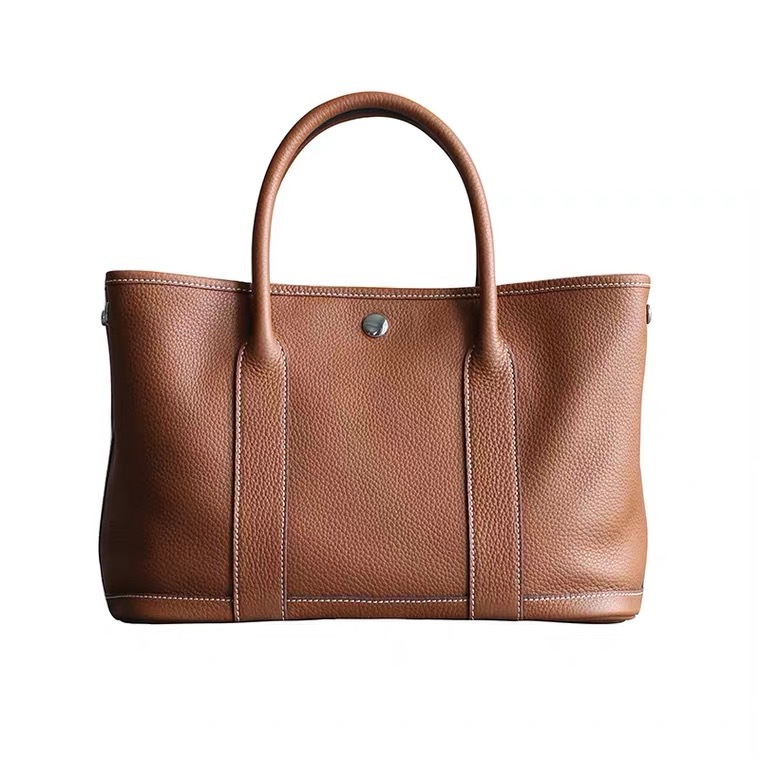The debate between PU leather and genuine leather has been going on for years, and both materials have evolved so much that the differences aren't always obvious at first glance. What is obvious is that shoppers want more clarity—especially as sustainability, durability, and craftsmanship matter more than ever.
Instead of giving another stiff, overly technical comparison, let's walk through the real-world differences: how these materials look and feel, how they age, how they hold up on a busy weekday commute, and even how they impact your budget and closet over time.
How PU Leather and Genuine Leather Are Made?
PU leather, short for polyurethane leather, is created by coating a fabric base—often polyester—with a flexible polymer. Some versions include a thin split leather backing (known as bicast leather), but most modern PU materials are fully synthetic. That's why PU is widely used in vegan leather handbags, minimalist backpacks, and lightweight travel bags. Many handbag manufacturers like it because it's easy to cut, color, emboss, and stitch.
Genuine leather, on the other hand, comes from animal hide. The tanning process can vary—chrome tanning, vegetable tanning, or hybrid methods—and the quality levels range from full-grain leather, top-grain leather, to lower-grade corrected leather. Higher grades retain the hide's natural marks, which many luxury brands treat as a badge of authenticity.
This core difference—synthetic vs. natural—plays a role in everything that follows: durability, maintenance, price, sustainability, and even scent.
Appearance: The Look and Feel in Real Life
PU leather has come a long way, and some high-end PU blends look surprisingly close to top-grain leather. Many shoppers even prefer the consistent texture and uniform coloring of PU tote bags, because real leather can show natural blemishes.
But if we're being honest, genuine leather still has an edge in depth and complexity. When you run your hand across a leather satchel or shoulder bag crafted from full-grain hide, there's a warm, slightly irregular surface that synthetic materials rarely replicate perfectly. If you want a handbag that evolves with time, leather is the one that—quite literally—grows with you.
Durability and Longevity
PU leather is fairly durable, but it has limitations. It can handle everyday wear, but exposure to high heat or UV sunlight can cause it to crack or peel over time. A PU crossbody or backpack used for light daily errands should last a couple of years, but it usually won't withstand a decade of wear. On the upside, PU is water-resistant because it's non-porous—you can get caught in the rain without worrying too much.
Genuine leather, especially top-grain or full-grain, tends to last significantly longer. It can handle friction, weight, and pressure without cracking easily as long as it's conditioned occasionally. Many leather handbags stay functional for ten years or more, and luxury pieces are often passed down. However, leather isn't naturally waterproof; water spots and stains can happen if it's not treated.
PU performs well for short-to-mid-term use and low-maintenance lifestyles, while genuine leather is the long-term investment piece that rewards periodic care.
Matt PU Leather Tote Bag Manufacturer
Quick Comparison Table: PU Leather vs. Genuine Leather
Below is a simple, at-a-glance overview that summarizes the two materials before we move into deeper details:
| Feature | PU Leather | Genuine Leather |
| Material Type | Synthetic (polyurethane) | Natural animal hide |
| Durability | Moderate; may peel or crack over time | High; can last 10+ years |
| Weight | Lightweight | Heavier, especially full-grain |
| Maintenance | Very low; wipe clean | Requires conditioning |
| Water Resistance | Naturally more resistant | Needs treatment |
| Price | Budget-friendly | More expensive |
| Aging | Does not develop patina | Develops patina over time |
| Ethical Choice | Vegan-friendly | Animal-derived |
| Ideal For | Trendy styles, lightweight bags, travel | Long-term investment pieces, premium handbags |
Weight and Comfort
PU leather is lighter, sometimes dramatically so. If you're shopping for large vegan leather handbags or oversized tote bags for commuting, PU can feel noticeably easier on the shoulder. That's why many travel bag brands choose it—they can offer a larger design without making the bag too heavy.
Genuine leather tends to weigh more, particularly when the hide is thicker or untreated. For small handbags like mini crossbodies or structured satchels, this isn't a big issue. But with large work totes, you may feel the weight before you even load your laptop inside.
Maintenance: What It Takes to Keep Each Material Looking Good?
If you want a low-maintenance lifestyle, PU leather has the advantage. You can wipe it down with a damp cloth, and it won't absorb oils the way real leather does. That makes PU practical for daily use in messy environments—think travel, commuting, or restaurant work where spills happen.
Genuine leather, however, requires conditioning every few months to prevent dryness. Some leathers need more care than others: full-grain leather absorbs products differently than corrected-grain materials.
Cost Differences: What You Really Pay For?
On average, PU handbags are significantly more affordable. You're paying for style and design rather than long-term durability. This makes PU leather appealing to students, trend-followers, and shoppers who rotate their handbags often.
Genuine leather bags come with a higher price tag because of the tanning process, craftsmanship, and longevity. You're investing not just in the name or look, but in material that can hold up over many years. Luxury brands—whether well-known designers or boutique handbag manufacturers—almost always use genuine leather because it conveys quality and tradition.
Neither is better; it comes down to whether you value affordability or long-term usability.
Sustainability: A More Complicated Issue Than It Seems
It's not as simple as saying PU is eco-friendly because it's vegan or that leather is sustainable because it lasts longer.
PU leather is cruelty-free, which matters to many buyers. But PU is still plastic-based, meaning it comes from petrochemicals and doesn't biodegrade quickly. Some newer PU alternatives are more eco-minded, but traditional PU isn't the greenest material.
Genuine leather uses animal hides, and opinions vary. Supporters argue that hides are byproducts of the meat industry, so leather helps reduce waste. Critics point to tanning chemicals and the environmental cost of livestock farming.
If sustainability is your top concern, the best path is comparing individual brands—some offer recycled PU, vegetable-tanned leather, or other low-impact processes.
Performance in Everyday Scenarios
To bring everything together, here's how the two materials perform in real-world moments:
For office use: A genuine leather work tote looks professional and holds up well under heavy weight like laptops and documents. PU is fine too, but may show corner wear sooner.
For travel: PU leather wins for lightweight convenience and weather-resistant surfaces. Many travelers specifically look for PU shoulder bags or PU backpacks for this reason.
For special occasions: Genuine leather has a richness that works beautifully for evening bags, formal clutches, or minimal crossbody bags with elegant stitching.
For daily casual use: Either works. PU is budget-friendly and easy to wipe clean; genuine leather adds a touch of sophistication to everyday outfits.
Genuine Leather Handbag Manufacturer
Which Material Is Better Overall?
There is no universal winner. There's only the material that suits your lifestyle.
Choose PU leather if you prefer:
● Lightweight handbags
● Lower prices
● Vegan-friendly materials
● Trendy styles you'll swap often
● Low maintenance
Choose genuine leather if you want:
● Long-term durability
● A material that ages beautifully
● A luxurious appearance
● Strong structure for heavy items
● Investment pieces
The right choice depends on how you live, what matters to you, and how often you like to switch up your personal style.
Conclusion
PU leather and genuine leather both have strengths that make them appealing in different ways. PU is affordable, practical, and offers countless style options without requiring much care. Genuine leather, meanwhile, is durable, luxurious, and becomes more beautiful with time. If you're choosing between a PU tote bag or a full-grain leather handbag, think about how you'll use it, how long you hope to keep it, and how much maintenance you're willing to do. There's no wrong answer—just the one that matches your personal priorities.



